Josiah Mason's Orphanage, Erdington, Birmingham, Warwickshire
Josiah Mason (1795-1881) was born in Kidderminster, the son of a carpet weaver. He was largely self-educated and tried his hand a variety of trades in his native town before moving to Birmingham in 1816. There he became involved in industries such as electro-plating, key-ring making, rubber ring making, and — most notably — the manufacture of steel pens and nibs through which he amassed a considerable fortune. He subsequently used much of his wealth for philanthropic purposes.

Josiah Mason, c.1869.
Mason's first orphanage was erected on Station Road, Erdington, and opened in 1858. The building originally accommodated thirty orphan girls who, in addition to a basic education, were taught baking, washing, and other domestic skills. The success of the institution led to its capacity being increased to fifty. Plans for a further extension eventually evolved into a scheme for an altogether much larger institution which would accommodate 300 or more children, two-thirds of them being girls and one-third boys.
The new building was situated on what was then called Bell Lane, soon renamed Orphanage Road. Its foundation stone was laid by Mason himself, privately, on September 19th, 1860, with the building being completed and first occupied in 1868. In addition to a reported expenditure of £60,000 on the building, the founder endowed the institutions with land and building estates with an estimated value of £200,000. Following the opening of the new orphanage, the Station Road premises were converted into almshouses for twenty aged women.
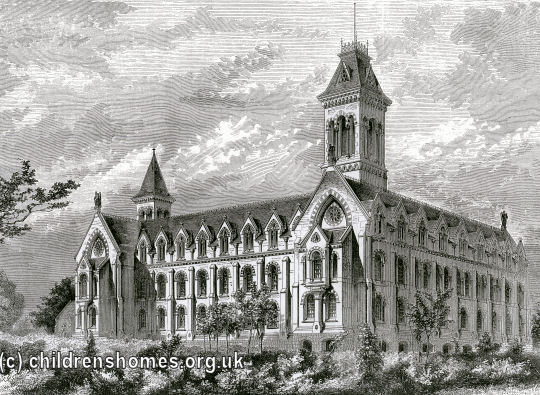
Josiah Mason's Orphanage from the south, Birmingham, c.1869. © Peter Higginbotham
The location of the home is shown on the 1937 map below.
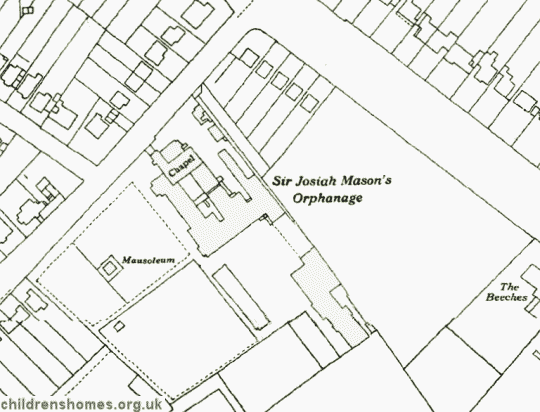
Josiah Mason's Orphanage site, Birmingham, c.1937.
The building, designed by J.R. Botham, was constructed in brick and had three prominent towers which acted both as chimneys for all the fireplaces but also assisted in the ventilation of the establishment. On the ground floor, at the left-hand end of the south-west front, was a library, with the chapel to its rear. Between the two projecting wings of the front were six private rooms used as offices, and the infants' nursery. At the angle of the building was the infants' school room. Along the south-east front were two store rooms, the officers' dining room, and the children's dining hall. Behind these were the kitchen and laundry, together with stores, pantries and servants' offices. On the first floor, above the library, was the infirmary. Eight bedrooms were placed above the private rooms, and the girls' sewing room above the infants' school room. Three classrooms lay over the stores and officers' dining room, and a school room over the dining hall. Above the kitchen were two lavatories (washrooms) and a store over the laundry. A girls' playroom was above some of the offices at the back. The second floor was occupied by dormitories. The basement under the whole of the south-east front was used as a covered playground.
Mason placed the ownership and management of the orphanage in the hands of a board of trustees. The trust deed specified matters such as how the education and religious instruction of the inmates was to be conducted, for example:
The who are admitted into the Orphanage are to be lodged, clothed, fed, maintained, educated, and brought up gratuitously at the exclusive cost of the Orphanage income.
Proper arrangements shall be made by the trustees for the instruction of the children, having due regard to their respective ages and capacities in reading, writing, arithmetic, geography and history.
All the children shall be brought up in habits of industry and, as far as possible, the girls be instructed in sewing, baking, cooking, washing, mangling, and in all ordinary household and domestic duties.
The children shall be carefully instructed in the knowledge of the Holy Scriptures in the authorised English version.
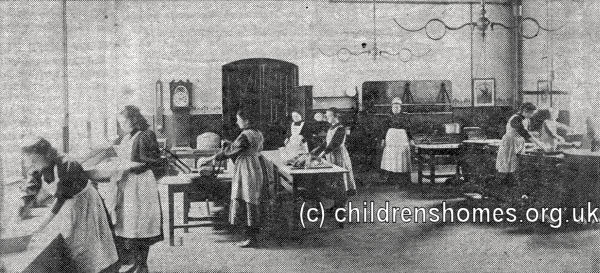
Josiah Mason's Orphanage kitchen, Birmingham, c.1890s.
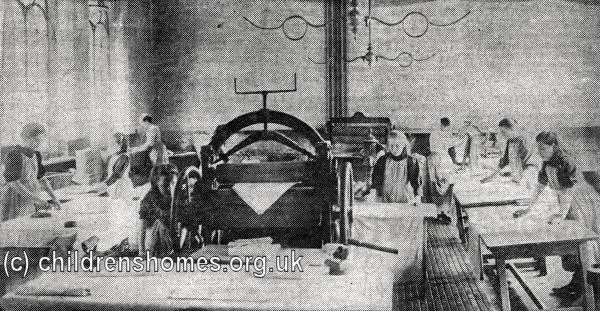
Josiah Mason's Orphanage laundry, Birmingham, c.1890s.
Unlike many other orphanages, Mason's demanded that candidates for admission were orphans in the strictest sense, namely that they were to be the legitimate children of parents both of whom were dead. Boys were required to be aged from seven to ten years old at their time of admission and left when they were fourteen; girls were admitted between four and ten years old, leaving at the age of fifteen. Certificates were required of the marriage and death of the parents, and of the birth of the child. Admissions were made by the trustees at meetings held for the purpose four times a year.

Josiah Mason's Orphanage from the south-west, Birmingham, c.1905.
In 1874, an additional block was built at the east of the site, containing dormitories and a school room for 120 boys. It was linked to the main building by a large new dining hall where up to 200 girls, 120 boys and 30 infants all met together for meals and prayers.
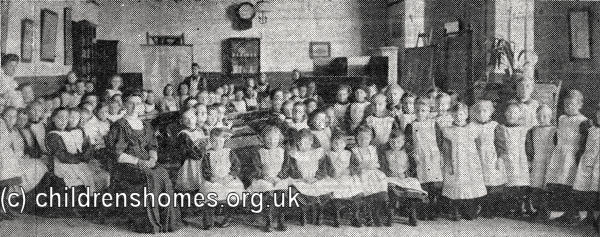
Josiah Mason's Orphanage inmates, Birmingham, 1908.
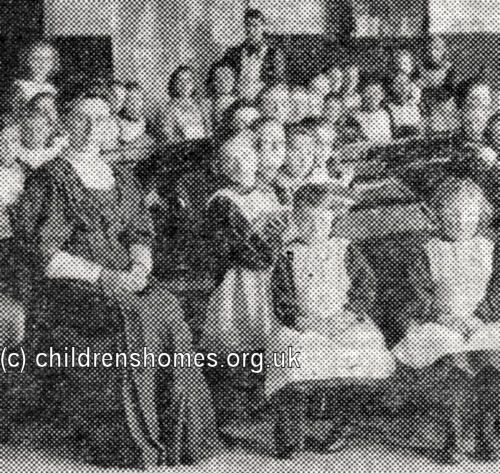
Josiah Mason's Orphanage inmates (detail), Birmingham, date unknown.
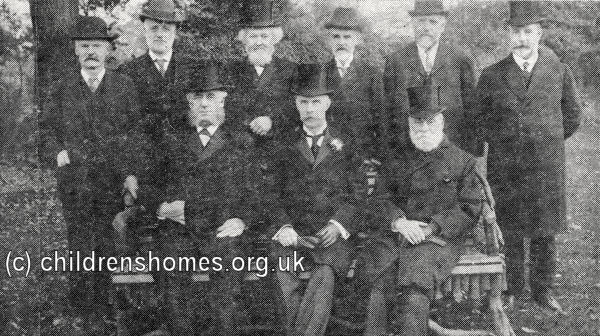
Josiah Mason's Orphanage Committee, Birmingham, c.1890s.
A mortuary chapel was erected in the grounds of the orphanage, in which the remains of Sir Josiah Mason and his wife were interred. He died at his residence, Norwood House, Erdington, on June 15th, 1881.
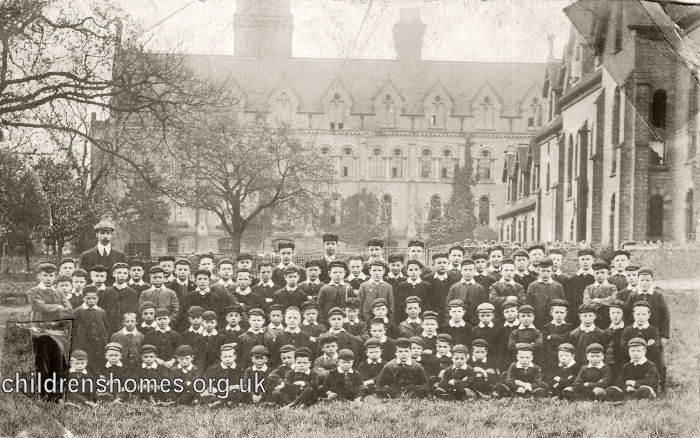
Josiah Mason's Orphanage boys, Birmingham, 1904.
On 26th July, 1919, the orphanage was formally accredited as a Certified School, allowing it to receive children boarded out by the workhouse authorities.
The orphanage's choir was highly regarded and was regularly featured in BBC radio broadcasts in the 1920s and 30s.
Following a steady decline in the number of its residents, the orphanage finally closed in 1964 and the buildings demolished to make way for a housing estate. Mason's work is continued by the Sir Josiah Mason Trust which provides a variety of housing and residential care for the elderly.
Records
Note: many repositories impose a closure period of up to 100 years for records identifying individuals. Before travelling a long distance, always check that the records you want to consult will be available.
- The Orphanage's records are said to have been destroyed by the Birmingham Social Services when the institution closed. The Old Masonians Association has a list of names of former residents.
- Birmingham Archives and Heritage Service, Library of Birmingham, Centenary Square, Broad Street, Birmingham B1 2ND. Has a small amount of material including photographs, architectural drawings, diet tables etc.
Census
Bibliography
- Limbrick, Gudrun Deeds of Love: the Story of Sir Josiah Mason's Orphanage and School, Birmingham (2013, Wordworks)
Links
Except where indicated, this page () © Peter Higginbotham. Contents may not be reproduced without permission.


